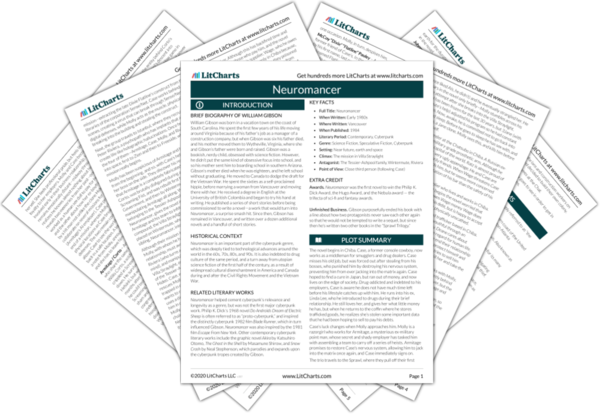Panther Moderns Quotes in Neuromancer
This was it. This was what he was, who he was, his being. He forgot to eat. Molly left cartons of rice and foam trays of sushi on the corner of the long table. Sometimes he resented having to leave the deck to use the chemical toilet they’d set up in a corner of the loft. Ice patterns formed and reformed on the screen as he probed for gaps, skirted the most obvious traps, and mapped the route he’d take through Sense/Net’s ice. It was good ice. Wonderful ice. Its patterns burned there while he lay with his arm under Molly’s shoulders, watching the red dawn through the steel grid of the skylight. Its rainbow pixel maze was the first thing he saw when he woke. He’d go straight to the deck, not bothering to dress, and jack in. He was cutting it. He was working. He lost track of days.
And sometimes, falling asleep, particularly when Molly was off on one of her reconnaissance trips with her rented cadre of Moderns, images of Chiba came flooding back. Faces and Ninsei neon. Once he woke from a confused dream of Linda Lee, unable to recall who she was or what she’d ever meant to him. When he did remember, he jacked in and worked for nine straight hours.
The cutting of Sense/Net’s ice took a total of nine days.

Unlock explanations and citation info for this and every other Neuromancer quote.
Plus so much more...
Get LitCharts A+The Panther Moderns allowed four minutes for their first move to take effect, then injected a second carefully prepared dose of misinformation. This time, they shot it directly into the Sense/Net building’s internal video system.
At 12:04:03, every screen in the building strobed for eighteen seconds in a frequency that produced seizures in a susceptible segment of Sense/Net employees. Then something only vaguely like a human face filled the screens, its features stretched across asymmetrical expanses of bone like some obscene Mercator projection. Blue lips parted wetly as the twisted, elongated jaw moved. Something, perhaps a hand, a thing like a reddish clump of gnarled roots, fumbled toward the camera, blurred, and vanished. Subliminally rapid images of contamination: graphics of the building’s water supply system, gloved hands manipulating laboratory glassware, something tumbling down into darkness, a pale splash….The audio track, its pitch adjusted to run at just less than twice the standard playback speed, was part of a month-old newscast detailing potential military uses of a substance known as HsG, a biochemical governing the human skeletal growth factor. Overdoses of HsG threw certain bone cells into overdrive, accelerating growth by factors as high as one thousand percent.












